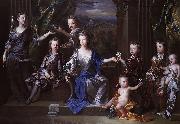Porslinet engros- Olja måleriet Engros- Måleriet Porslinet |
|||||||||||

|
|||||||||||
|
|
|
||||||||||||||
|
John Closterman
John Closterman (1660-1711) (also spelled Cloosterman, Klosterman), portrait-painter, born in Osnabruck, the son of an artist, who taught him the rudiments of design. In 1679 he went to Paris, accompanied by his countryman Tiburen, and there worked under Francois de Troy. In 1681 he came to England, and painted draperies for John Riley, at whose death, in 1691, Closterman finished several of his portraits. This recommended him to the Duke of Somerset, but he lost his favour on account of a dispute about a picture of Guercino, specially acquired for his grace, and which was afterwards purchased by Lord Halifax. In 1696 he was invited to the court of Spain, and executed the portraits of the king and queen; he also went to Italy twice, and made several acquisitions of works of art. On returning to England he obtained considerable employment, and married an Englishwoman. He buried his wife, Hannah, on 27 January 1702. According to Arnold Houbraken, he later took a mistress, who then ruined him by her extravagant habits, and ultimately left him in a state of dejection of body and mind that led to his ultimate decline. Jacob Campo Weyerman, who took much of his biographical material from Houbraken, states "Closterman had taken a beautiful mistress who, while he was away in the country, robbed him of his valuables and disappeared, actions which drove the painter into madness". He died in 1711, and was buried in Covent Garden churchyard. |
||||||||||||||
|
|
||||||||||||||
|
||||||||||||||
|
|
||||||||||||||
| John Closterman
John Closterman (1660-1711) (also spelled Cloosterman, Klosterman), portrait-painter, born in Osnabruck, the son of an artist, who taught him the rudiments of design. In 1679 he went to Paris, accompanied by his countryman Tiburen, and there worked under Francois de Troy. In 1681 he came to England, and painted draperies for John Riley, at whose death, in 1691, Closterman finished several of his portraits. This recommended him to the Duke of Somerset, but he lost his favour on account of a dispute about a picture of Guercino, specially acquired for his grace, and which was afterwards purchased by Lord Halifax. In 1696 he was invited to the court of Spain, and executed the portraits of the king and queen; he also went to Italy twice, and made several acquisitions of works of art. On returning to England he obtained considerable employment, and married an Englishwoman. He buried his wife, Hannah, on 27 January 1702. According to Arnold Houbraken, he later took a mistress, who then ruined him by her extravagant habits, and ultimately left him in a state of dejection of body and mind that led to his ultimate decline. Jacob Campo Weyerman, who took much of his biographical material from Houbraken, states "Closterman had taken a beautiful mistress who, while he was away in the country, robbed him of his valuables and disappeared, actions which drove the painter into madness". He died in 1711, and was buried in Covent Garden churchyard. Oil on canvas Dimensions 189.8 x 271.8 cm (74.7 x 107 in) cyf |
||||||||||||||
|
Related Paintings to John Closterman :. |
||||||||||||||
|
|
||||||||||||||
|
|
||||||||||||||
|
KOMMA I KONTAKT MED Oss |







